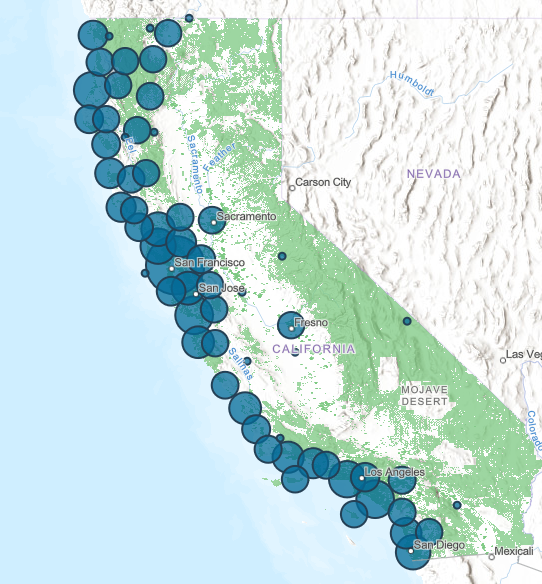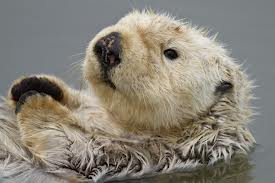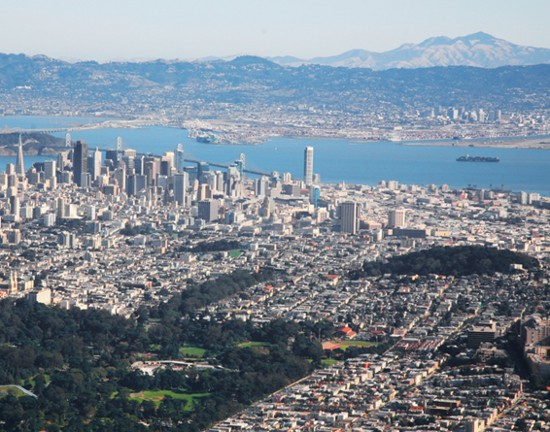San Francisco Bay Area
Along with being home to seven million people, the nine-county San Francisco Bay Area is home to a diversity of wildlife and habitats, world-class recreational opportunities, urban waterfronts, and working farms and ranches. These are the resources that the San Francisco Bay Area Conservancy Program works to protect and improve. The region is defined by the San Francisco Bay, whose edges are a mix of urban waterfronts and wetland habitats. The rivers that flow into the Sacramento and San Joaquin River Delta are the estuary’s primary source of freshwater; in addition, numerous smaller creeks and rivers flow into the Bay. The ridgelines that surround the Bay provide a greenbelt for wildlife and people and are home to iconic peaks – including Mount Tamalpais, Mount Diablo, and Mount Hamilton. Over the past twenty years, the Bay Area Program has worked with partners to allocate $387 million to over 700 restoration, protection, and public access projects in the Bay Area.
In May 2023, the Conservancy participated in a webinar with the EPA, NOAA and the San Francisco Bay Restoration Authority on accessing federal, state, and regional funding. A recording of the webinar can be found here.
Bay Area Conservancy Project Priorities
The San Francisco Bay Area Conservancy Program undertakes projects to improve public access to the bay, coast, ridgetops, and urban open spaces; to protect, restore, and enhance habitat, watersheds, scenic areas, and open space; and to provide open space and natural areas that are accessible to urban populations for recreational and educational purposes. In the Bay Area, the Conservancy works on the following:
- The Greenbelt — The San Francisco Bay Area Conservancy Program works with land trusts, parks departments, open space districts, and others to protect regionally significant habitats, connecting corridors, watersheds, scenic areas, and agricultural lands. Fee title acquisitions and conservation easements with willing landowners are tools used to protect land for wildlife, recreation, agriculture, and other values. The Conservation Lands Network guides our land protection efforts.
- Recreational Opportunities — As the region continues to grow in population, the acreage and accessibility of open space for urban populations needs to keep pace. We are working with others to complete four Regional Trails in the Bay Area: the Bay Area Ridge Trail, the San Francisco Bay Trail, the California Coastal Trail, and the San Francisco Bay Area Water Trail. In addition, we work to complete other trails, educational and interpretive centers, staging areas, piers, picnic areas, campgrounds, urban waterfronts, and other recreational amenities. The Bay Area Trails Collaborative’s Interactive Trail Map is also a great place to learn more about your local trails!
- Wetlands and Resilient Shorelines — Approximately 85% of the Bay’s tidal wetlands have been lost since the Gold Rush. The Baylands Ecosystem Habitat Goals Report calls for 100,000 acres of wetlands around the Bay. We are leading efforts for the restoration of the South Bay Salt Ponds, Napa River Salt Marsh, Hamilton and Bel Marin Keys, and Dutch Slough and are funding several other planning and restoration efforts. We are also implementing the recommendations of the Subtidal Habitat Goals Report, through such projects as the San Francisco Bay Living Shorelines project. With the Marin Community Foundation, we are administering a multi-year grant program to advance nature-based solutions in Marin county. And we are helping communities and wildlife prepare for sea level rise by analyzing risks and designing flood protection with nature.
- Watersheds — The local watersheds surrounding San Francisco Bay have been dramatically altered due to development, water diversions, and urban runoff. We are an active participant in the Integrated Regional Water Management Plan, representing the watershed functional area. We also fund local watershed plans and projects to improve watershed processes and functions, including creek and river restoration efforts. A particular focus is on removing barriers to migration and increasing habitat for steelhead trout, guided by the San Francisco Estuary Watersheds Evaluation by the Center for Ecosystem Management and Restoration.
- Estuary Blueprint – The San Francisco Bay Area Conservancy Program partners with local, regional, state, and federal government agencies, scientists, citizen advocates, non-profits, and businesses to carry out priority actions identified in the Estuary Blueprint. The Blueprint is a collaborative, comprehensive conservation plan to improve the health and resilience of the aquatic, wetland, upland, and riparian ecosystems of the San Francisco Estuary. A recent update to the plan addresses the dual stressors of climate change and population growth.
- Working Farms and Ranches — The Bay Area is fortunate to have a remarkable diversity of food produced within close range, and over 40% of Bay Area lands remain as farms and ranches. Oftentimes, these farms and ranches also serve as important habitat for fish and wildlife. The Conservancy works with land trusts, resource conservation districts, and federal agricultural programs to promote agricultural sustainability through innovative land practices, conservation agreements, and direct planning assistance.
- Environmental Education — The Conservancy has supported numerous education centers in the Bay Area, many in underserved communities, to allow children and adults to learn about wildlife habitats and our cultural heritage and to empower our next conservation leaders. In addition, through our Explore the Coast grant program, we have funded educational and interpretive programs that improve and encourage access to the coast and bay shoreline.
- Introduced Species — The San Francisco Estuary is one of the most invaded aquatic ecosystems on earth, with 90% of the species and biomass introduced. The Conservancy’s interest is funding the successful prevention, control, or eradication of invasive species that threaten important habitats. In particular, we are the lead agency for the Invasive Spartina Project. We also fund hands-on projects that involve students and community volunteers in removing invasive plants and planting natives in habitats around the Bay Area.
Bay Area Conservancy Projects
Click on the links below to find out more about the Bay Area Conservancy’s work.
- South Bay Salt Ponds
- Dutch Slough Wetland Restoration Project
- Hamilton Wetlands Restoration Project
- Highway 37 and the San Pablo Baylands
- Invasive Spartina Project
- Napa River Salt Marsh Restoration Project
- Bay Area Ridge Trail
- San Francisco Bay Trail
- San Francisco Bay Area Water Trail
- California Coastal Trail
- Subtidal Habitat Goals Report and Living Shorelines Project
- Conservation Lands Network
- Bay Area Annual Project Reports
Bay Area Conservancy Partners
San Francisco Bay Area
News
- Press Release: Coastal Conservancy Awards over $40 million for coastal access, restoration, and climate resilienceOakland, CA (4/18/2024) – Today, the Board of the State Coastal Conservancy approved grants totaling over $40 million for coastal access, restoration, and climate resilience. Among the grants awarded today are: A grant of up to $6,000,000 to Humboldt County Resource Conservation District to undertake the North Coast Wildfire Resilience Planning and Implementation Grant Program, which […] (Read more on Press Release: Coastal...)
- Coastal Conservancy Awards Grants for Coastal Access, Restoration, and Climate Resilience2/15/2024 – Today, the Board of the State Coastal Conservancy authorized a number of grants to restore, protect, and expand access to the California coast. Grants approved included: A grant of an amount not to exceed $35,000,000 to The Nature Conservancy to complete permitting and implement the first phase of the Ormond Beach Restoration Public Access […] (Read more on Coastal Conservancy Awards...)
- Press Release: State Coastal Conservancy Announces Awards for Coastal Resilience, Public Access, Restoration, and StorytellingSan Luis Obispo – This week, the California State Coastal Conservancy announced more than $39 million in funding for projects to improve public access, climate resilience, habitat values, and inclusion at the coast. “The Coastal Conservancy’s vision is of a beautiful, restored, and accessible coast for current and future Californians. To achieve this, we […] (Read more on Press Release: State...)

 Help Save Sea Otters at Tax Time
Help Save Sea Otters at Tax Time


